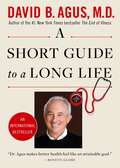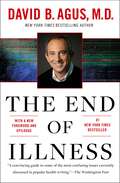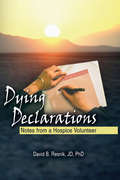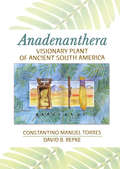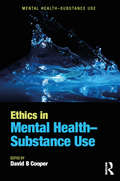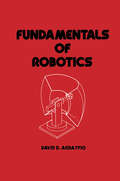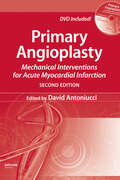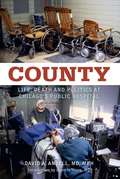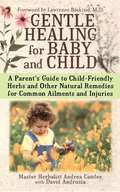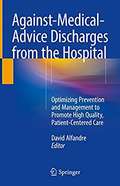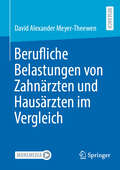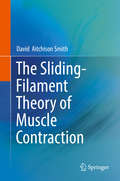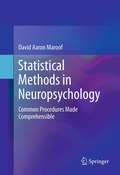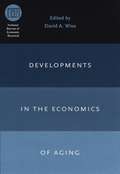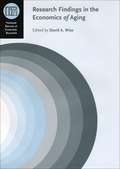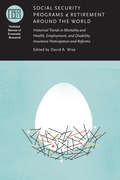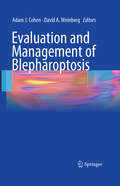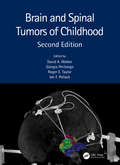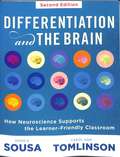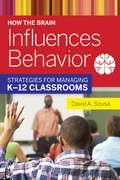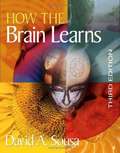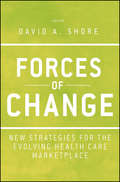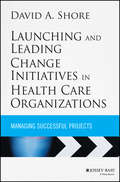- Table View
- List View
A Short Guide to a Long Life
by David B. AgusThe New York Times bestselling book of simple rules everyone should follow in order to live a long, healthy life, featuring illustrations throughout, from the author of The End of Illness.In his international bestseller, The End of Illness, Dr. David B. Agus shared what he has learned from his work as a pioneering cancer doctor, revealing the innovative steps he takes to prolong the lives of not only cancer patients, but all those who want to enjoy a vigorous, lengthy life. Now Dr. Agus has turned his research into a practical and concise illustrated handbook for everyday living. A Short Guide to a Long Life is divided into three sections (What to Do, What to Avoid, and Doctor's Orders) that provide the definitive answers to many common and not-so-common questions: Who should take a baby aspirin daily? Are flu shots safe? What constitutes "healthy" foods? Are airport scanners hazardous? Dr. Agus believes optimal health begins with our daily routines. His book will help you develop new patterns of personal health care, using inexpensive and widely available tools that are based on the latest and most reliable science. An accessible and essential handbook for preparing for visits to the doctor and maintaining control of your future, "A Short Guide to a Long Life explores the simple idea that a healthy tomorrow starts with good habits today" (Fortune).
The End of Illness
by David B. AgusCan we live robustly until our last breath? Do we have to suffer from debilitating conditions and sickness? Is it possible to add more vibrant years to our lives? In the #1 New York Times bestselling The End of Illness, Dr. David Agus tackles these fundamental questions and dismantles misperceptions about what "health" really means. Presenting an eye-opening picture of the human body and all the ways it works--and fails--Dr. Agus shows us how a new perspective on our individual health will allow us to achieve a long, vigorous life. Offering insights and access to powerful new technologies that promise to transform medicine, Dr. Agus emphasizes his belief that there is no "right" answer, no master guide that is "one size fits all." Each one of us must get to know our bodies in uniquely personal ways, and he shows us exactly how to do that. A bold call for all of us to become our own personal health advocates, The End of Illness is a moving departure from orthodox thinking.ness. A bold call for all of us to become our own personal health advocates, The End of Illness is a moving departure from orthodox thinking. This is a seminal work that promises to revolutionize how we live.
The Lucky Years: How to Thrive in the Brave New World of Health
by David B. Agus“If you buy just one health book this year, then get The Lucky Years” (Howard Stern). In this groundbreaking guide, bestselling author David Agus shows how we can take control of our health like never before in the brave new world of medicine.In his first bestseller, The End of Illness, David Agus revealed how to add vibrant years to your life by knowing the real facts of health. In The Lucky Years, he builds on that theme by showing why this is the luckiest time yet to be alive, giving you the keys to a new kingdom of wellness. In this new golden age, you’ll be able to take full advantage of the latest science and technologies to customize your care. Imagine being able to: edit your DNA to increase a healthy lifespan; use simple technologies to avoid or control chronic conditions like pain, depression, high blood pressure, and diabetes; prolong natural fertility and have children in your forties; lose weight effortlessly without a trendy diet; reverse aging to look, feel, and physically be ten years younger; and turn cancer into a manageable condition you can live with indefinitely. That’s the picture of the future that you can enter—starting today. With “practical health information fortified with exciting news from the forefront of modern medical technology” (Kirkus Reviews), this is an essential, important read. “If you have made a new year’s resolution to get healthier, you’ll find a buddy in David B. Agus’s new book” (The Boston Globe). Welcome to the Lucky Years.
Dying Declarations: Notes from a Hospice Volunteer
by David B Resnik"Death strips away all of the superficial and mundane details of living and leaves behind life&’s bare essentials."Death is inevitable in life. It knows no boundaries. It knows no skin color, no financial or social standing. It knows nothing but itself. The paradox of Dying Declarations: Notes from a Hospice Volunteer is in its warm affirmation of life through the &’dying declarations&’ of patients who are peering into the cold face of death. The author reveals personal experiences about life, death, and the courage to strip away the unimportant aspects of life to make way for a clearer understanding on just what is truly important. Simple, moving stories invigorate and spark insights-while discussing all aspects of hospice volunteering."By facing death on a regular basis, one can no longer maintain a tight grip on the masks, games, and trivialities that one uses to hide from truth. The person who looks death in the eye becomes more honest, grateful, compassionate, and humble." In Dying Declarations: Notes from a Hospice Volunteer, the author shares his experiences and the lessons he learned from the dying while working as a hospice volunteer. The stories, rather than being sad and depressing, present the author&’s hospice experience as being some of the most personally uplifting and enriching experiences of his life. In Dying Declarations: Notes from a Hospice Volunteer you will learn: about training for hospice work why hospice volunteers are at times more beneficial to the well-being of dying patients than family, clergy, or medical personnel the three basic tasks for a hospice volunteer how children and dogs can be beneficial for patients the impact that a dying patient can have on the life of a hospice volunteer words of wisdom about living life, directly from hospice patientsDying Declarations: Notes from a Hospice Volunteer will inspire and enlighten hospice volunteers, nurses, physicians, clergy, social workers or anyone who works for hospice or provides end-of-life care.
Anadenanthera: Visionary Plant of Ancient South America
by Constantino M Torres David B RepkeA multidisciplinary study of pre-Columbian South America-centering on the psychoactive plant genus AnadenantheraAs cultures formed and evolved in pre-Columbian South America, Anadenanthera became one of the most widely used shamanic inebriants. Anadenanthera: Visionary Plant of Ancient South America is more than a comprehensive reference on shamanic visionary substances; it is a useful tool for archeologists and pre-Columbian art historians. This thorough book examines the ritual and cultural use of Anadenanthera from prehistory to the present, along with its botany, chemistry, pharmacology, anthropology, and archeology.The earliest evidence for the use of psychoactive plants in South America is provided by remains of seeds and pods recovered from archeological sites four millennia old. Various preparations were derived from it with the intent of being a shamanic inebriant. Inhaled through the nose, smoked in pipes or as cigars, and prepared in fermented drinks, Anadenanthera served a central role in the cultural development of indigenous societies in South America. Anadenanthera: Visionary Plant of Ancient South America explores the full spectrum of information gleaned from research, covering numerous archeological sites in the Andean region, as well as discussing Amazonian shamanic rituals and lore. Analyses of the artistic expressions within the decorations of associated ceremonial paraphernalia such as ritual snuffing tubes and snuff trays are included. The text is richly illustrated with photographs and images of decorated ritual implements, and provides a comprehensive bibliography.Anadenanthera: Visionary Plant of Ancient South America explores: botanical aspects, taxonomy, and geographical distribution of Anadenanthera ethnographical, historical, and traditional aspects of Anadenanthera use chemical and pharmacological investigations of the genus and the various visionary preparations derived from it-with emphasis on the biologically active constituents theories of the mechanisms of action of the active tryptamines and carboline alkaloids comparisons of wood anatomy, morphology, and percentage of alkaloid content evaluation of stylistic and iconographic traitsAnadenanthera: Visionary Plant of Ancient South America is a thorough, useful resource for archeologists, anthropologists, chemists, researchers, pre-Columbian art historians, and any layperson interested in pre-Columbian art, archeology, or visionary plants.
Ethics in Mental Health-Substance Use (Mental Health–Substance Use)
by David B CooperEthics in Mental Health-Substance Use aims to explore the comprehensive concerns and dilemmas occurring from mental health and substance use problems, and to inform, develop, and educate by sharing and pooling knowledge, and enhancing expertise, in this fast developing region of ethics and ethical care and practice. This volume concentrates on ethical concerns, dilemmas, and concepts specifically interrelated, as a collation of problem(s) that directly or indirectly affect the life of the individual and family. Whilst presenting a balanced view of what is ethically best practice today, this title challenges concepts and stimulates debate, exploring all aspects of the development in treatment, intervention and care responses, and the adoption of research-led best practice.
Science in History: Toxic Histories
by David ArnoldToxic Histories combines social, scientific, medical and environmental history to demonstrate the critical importance of poison and pollution to colonial governance, scientific authority and public anxiety in India between the 1830s and 1950s. Against the background of India's 'poison culture' and periodic 'poison panics', David Arnold considers why many familiar substances came to be regarded under colonialism as dangerous poisons. As well as the criminal uses of poison, Toxic Histories shows how European and Indian scientists were instrumental in creating a distinctive system of forensic toxicology and medical jurisprudence designed for Indian needs and conditions, and how local, as well as universal, poison knowledge could serve constructive scientific and medical purposes. Arnold reflects on how the 'fear of a poisoned world' spilt over into concerns about contamination and pollution, giving ideas of toxicity a wider social and political significance that has continued into India's postcolonial era.
Fundamentals of Robotics
by David ArdayfioFundamentals of Robotics presents the basic concepts of robots to engineering and technology students and to practicing engineers who want to grasp the fundamentals in the growing field of robotics.
Primary Angioplasty: Mechanical Interventions for Acute Myocardial Infarction, Second Edition
by David AntoniucciThe Second Edition of Primary Angioplasty provides an update on the rationale, techniques, and effectiveness of direct percutaneous mechanical revascularization for acute myocardial infarction. Through the use of "real world" methods, clinical perspectives, and mechanical support, this comprehensive resource guides interventional cardiologists and
County: Life, Death, and Politics at Chicago's Public Hospital
by David Ansell"County" is the amazing tale of one of America's oldest and most unusual urban public hospitals. From its inception as a "poor house" dispensing free medical care to indigents, Chicago's Cook County Hospital has been both a renowned teaching hospital and the health care provider of last resort for the city's uninsured. "County" covers more than thirty years of its history, beginning in the late 1970s when the author began his internship, to the "final rounds" in 2002, when hundreds of former trainees and personnel, many of whom shared Ansell's vision of resurrecting a hospital in critical condition, gathered to bid the iconic Victorian hospital building an emotional farewell before it was closed to make way for a new facility."County" is about people--from Ansell's mentors, including the legendary Quentin Young, to the multitude of patients whom he and County's medical staff labored to diagnose and heal. It is a story about politics; from contentious union strikes, to battles against "patient dumping." Most importantly, it chronicles the battles for instigating new programs that would help to prevent, rather than just treat, serious illnesses, including the opening of County's HIV/AIDS clinic (the first in the city), as well as an early-detection breast cancer screening program. Finally, it is about an idealistic young man's medical education in urban America, a coming-of-age story set against a backdrop of race, segregation, and poverty.
Gentle Healing for Baby and Child
by David Andrusia Andrea CandeeGive your child the gift of natural health When your children are sick or injured, you want them to feel better -- fast. Although in some cases there is no substitute for traditional medical care, prescription drugs are not always the best answer. Countless parents are discovering that natural, health-promoting substances can often be both safer and more effective. Now, a master herbalist with more than twenty-five years of experience who is also a mother of two shares her natural approach to wellness. Inside you'll find easy holistic therapies for common childhood injuries and ailments, and learn: how a banana can remove a splinter which herbs help reduce fever how an onion helps both bruises and earaches why garlic is nature's antibiotic how a spritz of rosemary hair juice prevents lice why peppermint tea relieves both headaches and stomachaches how gargling with lemon juice and table salt can ease a sore throat why ginger root can ease motion sickness and many other intelligent uses of foods and therapeutic plants -- nature's own medicine -- to alleviate discomforts. Best of all, this invaluable reference stresses and approach that helps you teach you children the benefits of proventing illness -- not just treating it.
Against‐Medical‐Advice Discharges from the Hospital: Optimizing Prevention And Management To Promote High Quality, Patient-Centered Care
by David AlfandreFirst-of-its-kind text addressing the problem of against medical advice discharges in hospital-based healthcare.<P><P> Provides a comprehensive, multidisciplinary overview of a significant health care quality problem.<P> Addresses the legal, ethical, and institutional aspects of the problem as well as provides a framework for best practices for varied clinical disciplines including emergency medicine, pediatrics, psychiatry, hospital medicine, and nursing.<P>This first-of-its-kind text provides a multidisciplinary overview of a significant problem in hospital-based healthcare: patients who decline inpatient medical care and leave the hospital against medical advice (AMA). Compared to standard hospital discharges, AMA discharges are associated with worse health and health services outcomes. Patients discharged AMA have been found to have disproportionately higher rates of substance use, psychiatric illness, and report stigmatization and reduced access to care. By providing a far reaching examination of AMA discharges for a wide academic and clinical audience, the book serves as a reference for clinical care, research, and the development of professional guidelines and institutional policy. The book provides both a broad overview of AMA discharges with chapters on the epidemiology, ethical and legal aspects, as well as social science perspectives. For clinicians in the disciplines of hospital medicine, pediatrics, emergency medicine, nursing, and psychiatry, the book also provides a patient-centered analysis of the problem, case-based discussions, and a discussion of best practices. This comprehensive review of AMA discharges and health care quality will interest physicians and other health care professionals, social workers, hospital administrators, quality and risk managers, clinician-educators, and health services researchers.
Berufliche Belastungen von Zahnärzten und Hausärzten im Vergleich
by David Alexander Meyer-TheewenMit dieser empirisch belegten Studie über Zahnärzte und Hausärzte, die beiden bedeutendsten Gruppen in der medizinischen Versorgung der deutschen Bevölkerung, werden die Unterschiede hinsichtlich der berufsbedingten psychischen, physischen und existentiellen Belastungen sowie deren gesundheitlichen Auswirkungen bis hin zum Burnout herausgearbeitet. Basis der anonym durchgeführten Erhebung waren neben soziodemografischen Angaben und vier eigenen Items vier international validierte Fragebögen, die „Berufliche Belastung“ von Alfermann (2003), die „Beruflichen Gratifikationskrisen“ von Siegrist (2012), der „Gießener Beschwerdebogen GBB-24“ von Brähler und Scheer (1995) und die „Lebenszufriedenheit“ von Fahrenberg et al. (2005). Die vergleichende Befragung, die bezogen auf Deutschland die erste ihrer Art überhaupt ist, wurde online mittels SoSci geschaltet und von einschlägigen berufsständischen Institutionen in deren Medien angekündigt. Die nach Berufsgruppe, Geschlecht, Alter, Berufserfahrung und weiteren Kriterien differenzierten Ergebnisse zeigen auf, wie dringend Lösungsmöglichkeiten zur Bewältigung von Stressoren und Generierung und Stärkung von Ressourcen nötig sind, um für die nach Belastungsreduzierung nachsuchende Praxis Perspektiven nachhaltiger Resilienz aufzuzeigen.
The Sliding-Filament Theory of Muscle Contraction
by David Aitchison Smith<p>Understanding the molecular mechanism of muscle contraction started with the discovery that striated muscle is composed of interdigitating filaments which slide against each other. Sliding filaments and the working-stroke mechanism provide the framework for individual myosin motors to act in parallel, generating tension and loaded shortening with an efficient use of chemical energy. Our knowledge of this exquisitely structured molecular machine has exploded in the last four decades, thanks to a bewildering array of techniques for studying intact muscle, muscle fibres, myofibrils and single myosin molecules. <p>After reviewing the mechanical and biochemical background, this monograph shows how old and new experimental discoveries can be modelled, interpreted and incorporated into a coherent mathematical theory of contractility at the molecular level. The theory is applied to steady-state and transient phenomena in muscle fibres, wing-beat oscillations in insect flight muscle, motility assays and single-molecule experiments with optical trapping. Such a synthesis addresses major issues, most notably whether a single myosin motor is driven by a working stroke or a ratchet mechanism, how the working stroke is coupled to phosphate release, and whether one cycle of attachment is driven by the hydrolysis of one molecule of ATP. Ways in which the theory can be extended are explored in appendices. <p>A separate theory is required for the cooperative regulation of muscle by calcium via tropomyosin and troponin on actin filaments. The book reviews the evolution of models for actin-based regulation, culminating in a model motivated by cryo-EM studies where tropomyosin protomers are linked to form a continuous flexible chain. It also explores muscle behaviour as a function of calcium level, including emergent phenomena such as spontaneous oscillatory contractions and direct myosin regulation by its regulatory light chains. Contraction models can be extended to all levels of calcium-activation by embedding them in a cooperative theory of thin-filament regulation, and a method for achieving this grand synthesis is proposed. <p>Dr. David Aitchison Smith is a theoretical physicist with thirty years of research experience in modelling muscle contractility, in collaboration with experimental groups in different laboratories.</p>
Statistical Methods in Neuropsychology
by David Aaron MaroofThis book describes appropriate statistical models that are commonly utilized in neuropsychology. The book discusses such issues as developing normative data for neuropsychological measures, assessing the validity of neuropsychological tests, and quantifying change "over time" through longitudinal analyses. The rationale for and allure of the volume is the fact that there are no publications that dovetail the two subdisciplines of applied statistics and neuropsychology. The overall objective of this book is to provide a pragmatic and concrete source for applying methodological and statistical techniques in research studies whose emphasis includes neuropsychology. Since there are a plethora of technique to arrive at similar answers, each method with its strengths and weaknesses will be delineated. The beauty of the book will be that it will hopefully demystify commonly encountered issues faced with researchers. More specifically, it will provide a "how to do it" approach.
Developments in the Economics of Aging
by David A. WiseThe number of Americans eligible to receive Social Security benefits will increase from forty-five million to nearly eighty million in the next twenty years. Retirement systems must therefore adapt to meet the demands of the largest aging population in our nation's history. In Developments in the Economics of Aging, David A. Wise and a distinguished group of analysts examine the economic issues that will confront policy makers as they seek to design policies to protect the economic and physical health of these older Americans. The volume looks at such topics as factors influencing work and retirement decisions at older ages, changes in life satisfaction associated with retirement, and the shift in responsibility for managing retirement assets from professional money managers of traditional pension plans to individual account holders of 401(k)s. Developments in the Economics of Aging also addresses the complicated relationship between health and economic status, including why health behaviors vary across populations and how socioeconomic measures correlate with health outcomes.
Research Findings in the Economics of Aging
by David A. WiseThe social and economic effects of this shift are significant, and in Research Findings in the Economics of Aging, a group of leading researchers takes an eclectic view of the subject. Among the broad topics discussed are work and retirement behavior, disability, and their relationship to the structure of retirement and disability policies.
Social Security Programs and Retirement around the World: Historical Trends in Mortality and Health, Employment, and Disability Insurance Participation and Reforms
by David A. WiseIn nearly every industrialized country, large aging populations and increased life expectancy have placed enormous pressure on social security programsOCoand, until recently, the pressure has been compounded by a trend toward retirement at an earlier age. With a larger fraction of the population receiving benefits, in coming decades social security in many countries may have to be reformed in order to remain financially viable. This volume offers a cross-country analysis of the effects of disability insurance programs on labor force participation by older workers. Drawing on measures of health that are comparable across countries, the authors explore the extent to which differences in the labor force are determined by disability insurance programs and to what extent disability insurance reforms are prompted by the circumstances of a countryOCOs elderly population.
Evaluation and Management of Blepharoptosis
by David A. Weinberg Adam J. CohenThis comprehensive and detailed text deals with the diagnosis and surgery of blepharoptosis, and will benefit any practicing physician, fellow or resident who deals with blepharoptosis.
Brain and Spinal Tumors of Childhood
by David A. WalkerThis second edition comes at a time of a paradigm shift in understanding of the molecular pathology and neuroscience of brain and spinal tumors of childhood and their mechanisms of growth within the developing brain. Excellent collaborative translational networks of researchers are starting to drive change in clinical practise through the need to test many ideas in trials and scientific initiatives. This text reflects the growing concern to understand the impact of the tumour and its treatment upon the full functioning of the child’s developing brain and to integrate the judgments of the risks of acquiring brain damage with the risk of death and the consequences for the quality of life for those who survive. Information on the principles of treatment has been thoroughly updated. A chapter also records the extraordinary work done by advocates. All medical and allied professionals involved in any aspect of the clinical care of these patients will find this book an invaluable resource.
Differentiation And The Brain: How Neuroscience Supports The Learner-friendly Classroom
by Carol Ann Tomlinson David A. SousaStudents are becoming more academically and culturally diverse, making it more important than ever to shift away from a one-size-fits-all approach and toward differentiated instruction. The second edition of this best-selling book will help you create truly effective, brain-friendly classrooms for all learners. The authors share an array of updated differentiated instruction examples, scenarios, and exercises, as well as the latest educational psychology research from cognitive psychology, neuroscience, and pedagogy. Learn more about teaching diverse learners using brain-based learning strategies: Explore how the brain learns and approaches to differentiated instruction. Sharpen your knowledge of developmental cognitive neuroscience and educational psychology to teach the best content in the best possible way. Use the knowledge of educational neuroscience (neuroeducation) to benefit the students you teach. Design and implement strategies for effective differentiated instruction. Create a positive and productive learning environment that supports diversity in the classroom. A joint publication of ASCD and Solution Tree
How the Brain Influences Behavior: Strategies for Managing K?12 Classrooms
by David A. SousaCombining theory and practice, David A. Sousa helps educators understand what is happening in the brains of students with behavior problems and offers practical, effective intervention strategies compatible with current findings in neuroscience. In easy-to-understand language, the author presents current information on brain development and function and highlights factors that affect social and emotional decision-making and negative behaviors like impulsivity, defiance, and violence. Comprehensive yet concise, this guide for K-12 teachers and counselors provides methods for teaching self-control and fostering positive relationships with troubled students and provides case studies that match effective strategies with specific behaviors. Educators will find answers to critical questions such as: How does the rate of brain development explain erratic behavior of adolescents? What type of data collection can help teachers manage misbehavior? Can peer influence help curb misbehavior rather than encourage it? Why are boys more likely to misbehave than girls and what can teachers do about it? How do school and classroom climates affect student behavior? This invaluable handbook also features reproducible forms, worksheets, checklists, additional references, and an expanded list of primary research sources to help teachers understand and apply research-based principles for classroom and behavior management.
How the Brain Learns (3rd Edition)
by David A. SousaThe new, Third Edition of How the Brain Learns continues to focus on helping educators turn research on brain functioning into practical classroom strategies. This revised edition includes information on how the brain processes information and how this helps students learn, tips on maximizing student retention using "down time," and such familiar pedagogy from previous editions as the Practitioner's Corner, Key Points to Ponder, and pre- and post-assessments to measure the reader's knowledge. New to the third edition is: Updated information on the Information Processing Model to reflect newer terminology and understandings about memory systems Updated and exciting new research about language acquisition and how the brain learns to read An expanded chapter on thinking skills including the recently revised version of Bloom's Taxonomy More examples of how emotions influence learning and memory New Practitioner's Corners An updated resource section that includes additional books and Internet sites More primary sources for those who wish to review the actual research studies
Forces of Change: New Strategies for the Evolving Health Care Marketplace (Jossey-Bass Public Health #62)
by David A. ShoreAmerican health care has made great strides in the past hundred years. Life expectancy has increased dramatically and advances in medicine and treatments have eradicated many life-threatening diseases. However, in today's health care arena there is divergence between our health needs, the structure of our health care system, and how health care is delivered and funded. In Forces of Change, David A. Shore has collected the leading thinking from experts in the field on how our health care system can benefit from important lessons from other industries and effect transformational change that truly serves all stakeholders well. Contributors include Max Caldwell of Towers Watson; Michael J. Dowling of North Shore–Long Island Jewish Medical Health System; John P. Glaser of Siemens Healthcare; Ashish K. Jha of the Harvard School of Public Health; Eric D. Kupferberg of Northeastern University; Lucian Leape of the Harvard School of Public Health; Jeff Margolis of the TriZetto Group, Inc.; and David Shoultz of Philips Electronics.
Launching and Leading Change Initiatives in Health Care Organizations
by David A. ShoreImplement change that fosters sustainable growth and better patient careHealth care projects depend on astute management of change. But more than anything else, they depend on leaders who pay attention, who understand the importance of starting right, and who know how to launch projects that succeed. If leaders can increase the percentage of successful projects, patients, and practitioners everywhere will be better off and so will the organizations that depend on these projects for innovation.In Launching and Leading Change Initiatives in Health Care Organizations: Managing Successful Projects. Author David A. Shore of the Harvard School of Public Health speaks directly to the health care leaders and managers who see the need for change, but keep encountering nearly insurmountable challenges. Through his research, Shore discovered that most implementation failures occur because of a poor launch, and that strengthening processes and operations during the early weeks of a new project is a key to continued success. The book covers issues like:The preliminary groundwork that cultivates a stronger launchSystematic and selective project selectionBuilding the team that accomplishes changeSkill-building and record-keeping systems that foster sustainable growthLaunching and Leading Change Initiatives in Health Care Organizations gives leaders and managers the practical, easy-to-implement ideas and methodologies to start and manage projects successfully.
